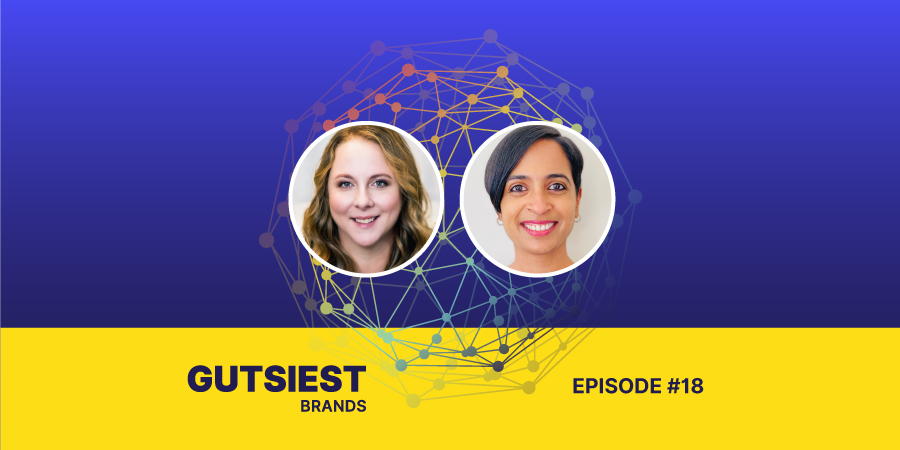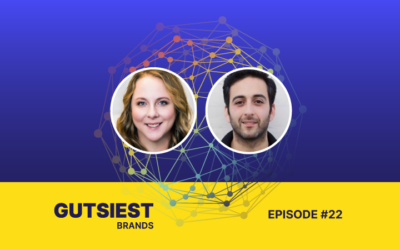
Embrace the Tension – Building Bold Brands and Amazing Teams
(highlights from Episode #18 of the Gutsiest Brands podcast)
Last month, GutCheck’s Chief Revenue Officer, Jess Gaedeke hosted me on an episode of the Gutsiest Brands podcast. We discussed how great marketing and great leadership are interconnected, not separate ideas. Our conversation wove together marketing skills like customer centricity, powerful storytelling, and bold idea generation with leadership skills like emotional intelligence, psychological safety, and being a talent magnet.
About me (Sudha Ranganathan): Currently a Director of Product Marketing on LinkedIn’s Talent Solutions business, I’ve spent my entire 17+ year career in marketing organizations, moving from P&G to PayPal to LinkedIn. And somehow, I’ve always known I’d end up in marketing, given my interest in brands and how they can captivate audiences with storytelling. Great brands appeal not just to your head but also to your heart and your gut, and I still feel that magic when I see great marketing today.
Below, you’ll find a distillation of lessons from our conversation – how great marketing and leadership come together to help businesses succeed.
Takeaway #1 – Decoding Empathetic Leadership
The key to a company’s success is often their leadership’s ability to lead with empathy within the organization. I break down empathy into three skill sets: listening for feedback, psychological safety, and closing the loop with action:
• Listening: Often, organizations forget that their values are really an amalgamation of the people that work there. Listening for what’s working (or not!) on a team is key to understanding if your company values are simply words or if they’re operationalized into ways of working.
• Psychological safety: Creating a space where individuals feel free to share feedback and ideas without fear of retaliation, explicit or implicit. Listening doesn’t yield the truth unless there’s safety in the environment.
• Closing the empathy loop with action: A safe environment and listening won’t yield any change unless the leader closes the feedback loop with meaningful action. For example, unless leaders prioritize fixing issues that employees were brave enough to voice in a culture survey, there’s no motivation for employees to continue sharing feedback. Why bother if it’s not changing anything?
Takeaway #2 – A Deep Dive into Psychological Safety
Here are some practical ways to make psychological safety happen in your organization:
• Step one: Have leaders who are able to demonstrate truth-telling by occasionally talking about what’s not working instead of putting a positive spin on everything.
• Step two: Incentivize truth-telling in your team by:
◦ Encouraging questions and productive disagreement in team settings, instead of trying to take them ‘offline’
◦ Truly listening to contrary opinions with an open mind – real, not performative curiosity
◦ Incorporating productive feedback into your decisions when they make sense
◦ Closing the loop by publicly sharing the impact of feedback and (publicly) rewarding team members that do this well
Takeaway #3 – Great storytelling touches the head, the heart, & the gut through powerful insights
When it comes to marketing, there’s a real temptation to focus on functional superiority through features, ingredients, and numeric claims. While all of this appeals to the thinking center (the head), real behavior change only happens when we’re moved in our heart and gut.
Emotional resonance like this only comes from powerful storytelling that showcases known, but unspoken truths, aka insights, about our consumers.
Ariel laundry detergent in the late 2000’s was no different. We were all about functional superiority with stain removal. And while functional superiority was a strong foundation to brand building, it wasn’t a path to emotional resonance with our audience. In 2020 (well after my time), Ariel launched Share the Load, a bold campaign idea that spoke to a well-known truth about inequity in the division of labor at home. Now, bold ideas are risky, but the provocation that makes your idea polarizing to some consumers is also what makes it appealing to others.
Takeaway #4 – The future of work is in skills & values
We will soon reach a tipping point where we will start to see a shift from matching candidates and jobs based on pedigree to matching based on skills and values. This shift will open up expanded talent pools, create more career mobility across functions, more equitable hiring, and a greater emphasis on values alignment, especially with the influx of GenZ into the workforce.
Watch out for this shift – skills are the currency of the future and I’m betting on them!
Takeaway #5 – Rethink Retention; Internal Mobility is the key to keeping talent engaged & growing
In her book, ‘Multipliers’, Liz Wiseman talks about the difference between Talent Magnets – leaders who develop their talent and support them moving to bigger, better things – and Empire Builders – leaders who hoard talent at any cost.
In this conversation, I emphasize how we need to rethink our approach to retention, inspired by Caroline Wanga, a guest at LinkedIn’s Talent Connect event, who argued why retention at all costs is harmful to a company.
In our obsession with retaining people we often lose sight of what they need to grow. The truth is, you sometimes have to let people go on to something better because they’ve hit their ceiling in your team or your organization.
How do we do this?
Internal mobility is a great system-over-sub-system solution to helping talent grow while also benefiting the organization. Often this can look like helping talent move to another team where they can grow, even if your immediate team loses them. A loss for one team could be a win for the company at large!
Takeaway #6 – Customer Insights to Action – Going from the ‘what’ to the ‘so-what’ & ‘now-what’
Marketing feminine hygiene products in India was a challenge with only 12-15% of menstruating women using sanitary napkins. Major price and cultural barriers meant getting sanitary napkins into the hands of women and girls who needed them was an uphill battle. However, by understanding that using cloth pads led girls to be uncomfortable and missing school (the ‘what’), our team at Always was able to create campaigns that addressed parents’ concern for their daughters falling behind in their education (the ‘so-what’), creating the impetus to replace cloth pads with sanitary pads (the ‘now-what’).
Always’ school program also helped girls get menstruation-ready by educating them (something their parents were hesitant to do at home) and providing free samples to help them through their first period.
My best advice for brand builders – Embrace the Tension.
Embracing the tension is very similar to ‘the power of AND.’ You can have seemingly opposing ideas, but when you bring them together and find the magic embedded in the tension, you can truly push the edges of brands.
Keep Learning
Catch up on Jess and my full interview by listening to the Gutsiest Brands podcast.
From the GutCheck team:
If you are interested in how your brand can uncover the deep customer insights that can enable you to lead with empathy, pioneer new paths, stand behind bold ideas, and lean into ‘the power of AND’, we’d love to help. Drop us a note!
Written By
Want to stay up to date on the latest GutCheck blog posts?
Check Out Our Most Recent Blog Posts
When Vocation and Avocation Collide
At GutCheck, we have four brand pillars upon which we build our business. One of those is to 'lead...
Reflections on Season 1 of Gutsiest Brands
Understanding people is at the heart of market research. Sure, companies want to know what ideas...
Permission to Evolve with Miguel Garcia Castillo
(highlights from Episode #22 of the Gutsiest Brands podcast) Check out the latest lessons from our...
1-877-990-8111
[email protected]
© 2023 GutCheck is a registered trademark of Brainyak, Inc. All rights reserved.
© 2020 GutCheck is a registered trademark of Brainyak, Inc. All rights reserved.




